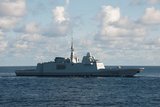Ultra Gigasat selected to be part of Raytheon troposcatter team
Gigasat, part of Ultra Electronics Communication and Integrated Systems (CIS) has been selected to be part of a Raytheon team providing a troposcatter communications system to the US Army.
The system is being delivered under a ten year, indefinite-delivery, indefinite-quantity contract to provide personnel access to secure voice and data communications in contested environments.
Troposcatter communications systems allow troops to establish a communications capability in the field in areas where access to a trusted source of satellite communications coverage is not available.
Following a competitive testing and analysis process, Raytheon selected Ultra Gigasat’s troposcatter antenna to provide the US Army with a secure and easily deployable capability to facilitate mission-critical communications between soldiers in the field and command and control.
The troposcatter terminal has been designed to operate in a multitude of environments, ensuring that wherever troops are conducting missions they have access to a reliable communications system.
‘The operational requirements of today mean that troops are required to deploy to a variety of environments where access to satellite coverage and power is not guaranteed,’ Mark Aitken, business unit director at Ultra Gigasat, said.
‘Reliable, secure communications is a vital component of operations and is essential not only to the success of missions, but also to protecting soldiers’ safety. Our partnership with Raytheon will ensure that the capability is readily available to provide soldiers with deployable communications tools, regardless of whether or not satellite coverage is available.’
Ultra Gigasat says that its troposcatter antenna has undergone design, testing and development to ensure it can be deployed to any field of operation, is easily assembled with no requirement for additional components, and can quickly establish a secure communications function.
The system has been optimised for transportability, weight and size, maximising the range of transport platforms that can deploy the terminal to a site whilst not placing additional demands on the operation.
Once installed and aligned, the terminal provides a stable platform to transmit and receive data, even in harsh conditions or severe environments.
More from Digital Battlespace
-
![Babcock nears first customer for Nomad AI translation tool]()
Babcock nears first customer for Nomad AI translation tool
Nomad can provide militaries with real-time intelligence, saving critical time on the battlefield.
-
![AUSA 2025: Israel’s Asio Technologies to supply hundreds of improved Taurus tactical systems]()
AUSA 2025: Israel’s Asio Technologies to supply hundreds of improved Taurus tactical systems
Taurus operates alongside the Israel Defense Forces’ Orion system which supports mission management across tens of thousands of manoeuvring forces, from squad leaders to battalion commanders.
-
![AUSA 2025: Kopin pushes micro-LED plans as China moves faster]()
AUSA 2025: Kopin pushes micro-LED plans as China moves faster
The plan for the new displays follows fresh investment in Kopin’s European facilities by Theon and an order for head-up displays in fielded aircraft, with funding from the US Department of Defense.
-
![AUSA 2025: Persistent Systems to complete its largest order by year’s end]()
AUSA 2025: Persistent Systems to complete its largest order by year’s end
Persistent Systems received its largest ever single order for its MPU5 devices and other systems earlier this month and has already delivered the 50 units to the US Army’s 4th Infantry Division.
-
![Aselsan brings in dozens of companies and systems under the Steel Dome umbrella]()
Aselsan brings in dozens of companies and systems under the Steel Dome umbrella
Turkey has joined the family of countries attempting to establish a multilayered air defence system with government approval in August 2024 for the effort landed by Aselsan. Dubbed Steel Dome, the programme joins Israel’s Iron Dome, the US Golden Dome, India’s Mission Sudarshan Chakra and South Korea’s low-altitude missile defence system.
-
![DSEI 2025: MARSS unveils new agnostic multidomain C4 system]()
DSEI 2025: MARSS unveils new agnostic multidomain C4 system
MARSS’ NiDAR system has been deployed using sensors from static platforms to provide detection and protection for static sights, such as critical infrastructure, ports and military bases.



























